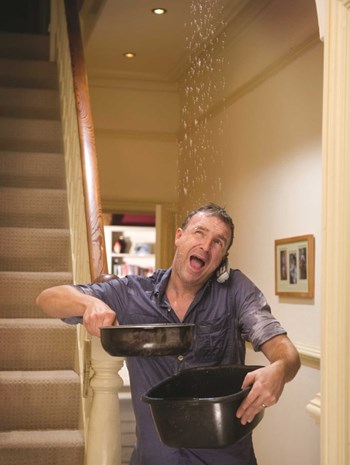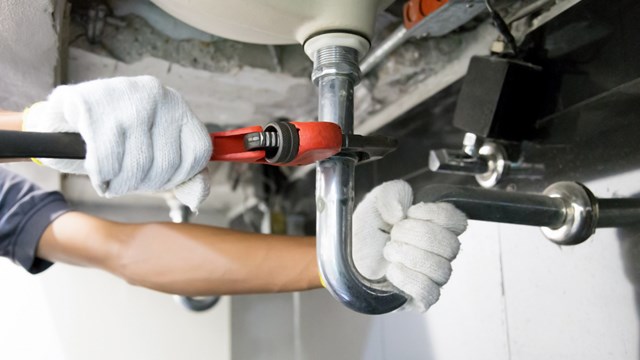
As we go about our busy lives, we often forget about the plain facts of life here on this spinning globe: gravity creates an unceasing tension in the materials we assemble into buildings and other structures. Whether or not we are paying attention, all of matter is reacting to gravity’s pull, and those forces can result in small tears or holes in facades, roofs and other parts of a building.
Over time, such stresses can result in a hole in a roof, oftentimes at a plane change area, such as where flashing surrounds a skylight or a chimney. Even if it’s just a pinhole leak to start, if it is left undetected for very long, that dripping water can cause serious damage to a building and even adversely affect its structural integrity.
Water leaks are the bane of many homeowners and many condominium building engineers or superintendents. But unlike a drippy faucet or a drafty window, which often can be simply fixed, water leaks sometimes can be very difficult to find and remedy. Many different technologies exist to help find the source and the extent of leaks and other technologies can help minimize the damage these leaks cause. Knowing what makes leaks happen, the ways that they are found, and how they’re repaired is essential for anyone living in a multifamily building. Because after all, such a leak might happen in nearly anyone’s unit and still affect everyone in the condo because of a costly fix that all will have to pay for.
Spotting Problems
A longstanding leak might signal the need for a major building improvement project, but it might also require a less invasive solution, such as a spot replacement of just part of a roof. Knowing what solution to use is the contractor’s bailiwick, but understanding something about the fixes for water leaks, and the best practices for finding the source of the leaks, is the responsibility of each building resident.
Water leaks in a condo building are generally of two kinds: rain-related or plumbing-related. “Rain-related leaks are any type of water intrusion that typically occurs only when rain occurs during storms. It’s when rain is forcing water against a window or against a roof. It’s usually related to a heavy rain and wind blowing,” says Karen Peterson, co-owner of American Leak Detection, the franchisee that covers Palm Beach, Martin and St. Lucie counties. “Plumbing-related leaks are constant. The way you can tell if you have plumbing-related leak is to take a look at your water meter. If the water meter is spinning when no water is being used that means you have a leak in your potable plumbing. That’s the plumbing that goes from the water meter to the water fixtures. It’s your hot and cold water line and that plumbing is always under pressure, when you go to turn on your faucet you get water immediately, that’s because it’s under pressure. The water meter doesn’t know the difference when you turn on a faucet or if the water is coming out of a leak. The water meter will move when no water is being used if you do have a leak.”
Experts agree that roofs, windows and potable plumbing are all common sources for leaks across South Florida.
“It’s very common for water to get in through windows in South Florida,” says Barrington Watson, owner of Watson’s Painting & Waterproofing Company in Lauderdale Lakes, “It rains a lot here. Our rainy season is June through September.”
A leak doesn’t always have to be particularly severe before residents notice water stains or seepage in the walls or ceiling, and some leaks will show up more or less immediately. Other leaks could be happening for weeks before anyone notices. Some leaks might not be evident in any way, such as a pipe leak for which the building’s management can’t find the source. Such a leak might initially be detected through the water meter of a condo’s HVAC system.
“In South Florida, a big cause of water leaks is potable plumbing,” says Peterson. “That’s the hot and cold water lines that are located in the slab and oftentimes from the ground shifting and wear-and-tear leaks develop in those particular plumbing lines. These are the lines that go from the water meter to the fixtures. That’s a very common situation in South Florida.”
Some companies, like American Leak Detection, stick strictly to the inspection side of this business. The company finds water leaks non-invasively—without excavation or demolition. For exterior water penetration issues, American Leak Detection uses thermal imaging technology and also electric vector mapping, which employs an electric current and water to find even a pinhole-sized tear. Infrared or “thermal” imaging can often find a leak’s source quickly.
Since a leak in a multifamily building can come from different spots on a large surface such as the building’s exterior, thermal imaging covers all of that territory by looking for a temperature signature on the surface that indicates where the leak is located. The technology helps a professional to find areas of the building that are water-damaged. When used on a roof, a thermal imaging device scans the surface horizontally, detecting where moisture is trapped within the roof.
“Locating plumbing related water leaks is a two-step process,” says Peterson. “The first thing we have to know is where the plumbing is located. We go to where the plumbing is exposed like a hose bed and we send an electrical signal down the plumbing line with a pipe line locator. The pipe line locator will send a signal under the slab so that we’ll know where the plumbing is located. Once the plumbing is located we induce a low pressure of nitrogen into the plumbing putting it under pressure and we basically force it to make a sound. The water and nitrogen combined as they escape from where the leak is, creates a sound that we can hear with electromagnetic equipment. It’s proprietary equipment to us. The best analogy I can make is if you go to a children’s birthday party and if you blew up a balloon and if there is no leak in that balloon then that balloon is going to hold air, but if you put a little pin prick in that balloon then it’s going to make a noise as the air comes out. That’s exactly what we do—we make your leak make sounds so we can hear exactly where the problem is.”
This ultrasound technology can find an active leak of water or steam. This technology though isn’t used on roofs, for obvious reasons—it’s too loud outside for the technology to work.
“We locate a water leak with a moisture radar,” says Jason Green, operations manager for Prachel Painting, Waterproofing & Restoration in Boca Raton. “It’s a tool that you can point at dry wall and see if there’s moisture in the walls or floors. We use it a lot. It’s very common in South Florida.”
Another fairly routine way of inspecting a building to find water leaks is doing a roof survey. In a roof survey, the condo building’s management will call in a professional, who will do a thermal imaging survey of the entire roof. He or she will also take photos of the roof and then mark with paint any damaged area of the roof. Generally, a professional will offer spot fixes of the roof when small parts of it are damaged or leaking.
“If a large portion of the roof is leaking it’s better to replace the roof than fix the leak,” says Green. “If you have a large portion of the roof leaking and you would only replace the portion that leaking what’s not to say that the existing portion is not going to leak. If you put a Band-Aid on one section and that holds, it’s going to find another point of access for leaks, the older point is going to the point of access. If you’ve got 50 percent of the roof leaking you might as well replace it. It’s cost effective.”
The single most effective preventative step to take to avoid roof leaks is proper gutter and downspout maintenance. Make sure these parts of the building are always clear and free of obstructions, by regularly cleaning them.
One method of detecting leaks in a roof sort of imitates what happens when a gutter or downspout is clogged—it backs up water onto one part of the roof. By creating a dam made of sheet metal around an area of a flat roof surface and then applying water to that area where the leak was, specialists can trace a leak to see where the water is coming into the building.
Repairing Leaks
The most common source of water leaks in suburban multifamily buildings is the roof. Areas of the roof where flashing is used typically are the weakest points on the roof surface, and are the spots most likely to develop a leak. Because each leak is unique, there’s no rule of thumb for how long it can take to find a water leak. Finding the source of the problem might take just a couple of hours, or it might require many hours of work, depending upon the size of the property.
Costs for bringing in a leak detection specialist vary. Several different types of professionals are qualified to do the job, including firms that refer to themselves as leak detection specialists, as well as engineers or contractors with expertise in the area. Hiring such professionals can start at $600 per man per day, and often two men are needed to inspect for a leak problem. Some day rates range upwards of $2,000.
Knowing how to pick the right company to handle the job is a matter of matching up skills and needs. For a whole building leak problem, management always should consult the building’s engineer regarding how to proceed. If they pay attention, though, building owners and management will be able to pick out the best firms to do the work, based in part upon what they say.
When they are found, leaks are repaired in various ways. The type of fix for a leak always is dependent upon the type of problem, but conditions of the building material that is affected, the age of the building component (such as a roof, stone façade, or even steel window lentils), and the size and scope of the leak all factor into a remedy. The amount of damage caused by the leak also is part of the equation.
Not every contractor will give an ironclad guarantee on his work, but many are passionate about their jobs, and dedicated to helping their clients. These are the specialists that a building’s management should be working to find, because they will do the job right.
Jonathan Barnes is a Pittsburgh-based freelance writer and a frequent contributor to The South Florida Cooperator. Staff Writer Christy Smith-Sloman contributed to this article.






Leave a Comment